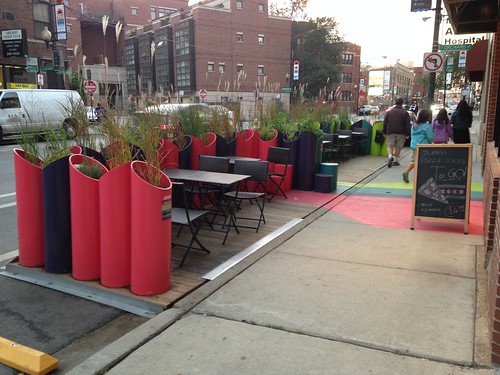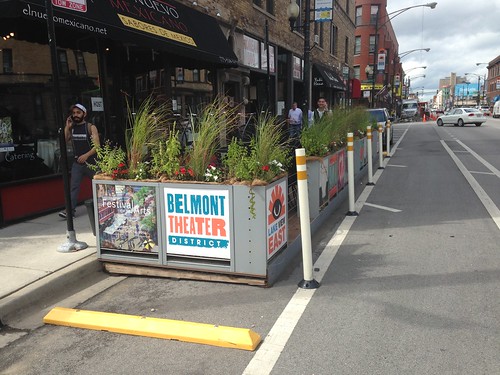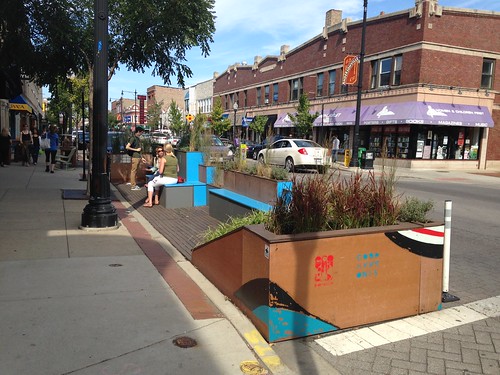In July, two new “People Spot” mini parks debuted on an Lackluster segment of Clark near Wellington, as part of a larger campaign to revitalize the business strip.
The new parklets are located in front of El Nuevo Mexicano restaurant, 2914 North Clark, and Osteria De Pizza Metro, 2863 North Clark. They cost a total of about $35,000, which was bankrolled by the local special service area, and they’re manged by the Lakeview East Chamber of Commerce, according to executive director Maureen Martino. “Sometimes it’s a challenge to activate a street,” she said. “We’re hoping this will bring more customers for local businesses.”
Judging from a recent report by the Metropolitan Planning Council, the People Spots should help make this somewhat sleepy stretch of Clark livelier and more profitable. About 80 percent of the merchants surveyed said that the parklets, which occupy space in a parking lane, increased foot traffic on their block and helped bring shoppers to their establishments. Some credited the People Spots with contributing to a 10 to 20 percent increase in sales since they were installed.
The parklet by the Mexican restaurant replaced a loading zone and one metered car space, while the one by the Italian eatery used two parking spots. In compliance with the city’s parking contract, the three spaces were replaced with new metered spots on nearby streets. The People Spots will revert to parking on November 1, and they’ll be reinstalled in the spring.
Both spaces feature café-style tables and chairs, plus free Wi-Fi. Duane Sohl, from Sohl.Architect, designed the one by El Nuevo Mexicano. It’s surrounded by metal planter boxes featuring framed panels designed by local artists.
The other parklet, created by Katherine Darnstadt of Latent Design, is enclosed by a fence made of large PVC plastic tubes, which double as planters. The red, purple and green colors of the tubes playfully spill over onto the sidewalk as a rainbow-like paint puddle that leads to the restaurant’s storefront. The People Spot is titled “Color Guard,” and Martino said the name reflects the diversity of the neighborhood.
Signs on the People Spots make it clear that the seating is open to the public. However, since the spaces resemble sidewalk cafes, and are located by sit-down restaurants, some passers-by may assume that they’re reserved for paying customers. Martino said the chamber may change some of the seating next year to make the spaces more inviting for different uses, as is the case at more free-form parklets at Southport and Addison, and in Andersonville.
The city’s rules for People Spots currently don’t allow them to be used for table service. Martino said she’d like to see an option created where eateries could pay to locate outdoor seating specifically for their patrons in the parking lane, similar to the permitting process for sidewalk cafes. “We allow food trucks to use street space,” she said. “Why not give brick-and-mortor businesses the option to use that space as well?”
While nearby retail districts on streets like Broadway, Halsted, and Southport have seen increased business in recent years, Martino said commerce on this stretch of Clark between Belmont and Diversey has declined. She said part of the problem has been relatively fast car traffic on Clark, narrow sidewalks that don’t provide room for comfortable walking or sidewalk cafes, and a lack of trees and green space.
“We’ve been a big advocate for trying to widen the sidewalks for the last decade,” Martino said. Although the chamber has lobbied local alderman Tom Tunney and the Chicago Department of Transportation about this, one issue is that the current sidewalks are vaulted, which makes them expensive to rebuild.
Martino said that the recent addition of buffered bike lanes on Clark has helped somewhat, by slowing down car traffic. “When you calm traffic, it makes people more likely to notice things around the area,” she said.
Last month, the Clark Street Task Force released the North Clark Street Strategic Plan, with ideas for addressing the strip’s challenges. The task force is made up of the chamber, local property and business owners, city officials, and the urban planning firm Lakota Group.
The report includes a bold vision of what the strip could look like if it was reconfigured to make it more people-friendly. One streetscape proposal calls for widening the sidewalks to 12 feet, while creating 13-foot-wide travel lanes that would include green “priority bike lanes.” Although 13 feet would normally be considered too little road width for a car lane plus a mixed-traffic lane, under this set-up motorists would be permitted to enter the bike lane when necessary.
Other ideas in the plan include large sidewalk bumpouts to shorten pedestrian crossing distances, and provide space for street trees, planters, and sidewalk cafes. If the task force succeeds in making this vision a reality, it should go a long way to make the business district safer, more vibrant, and more prosperous.









